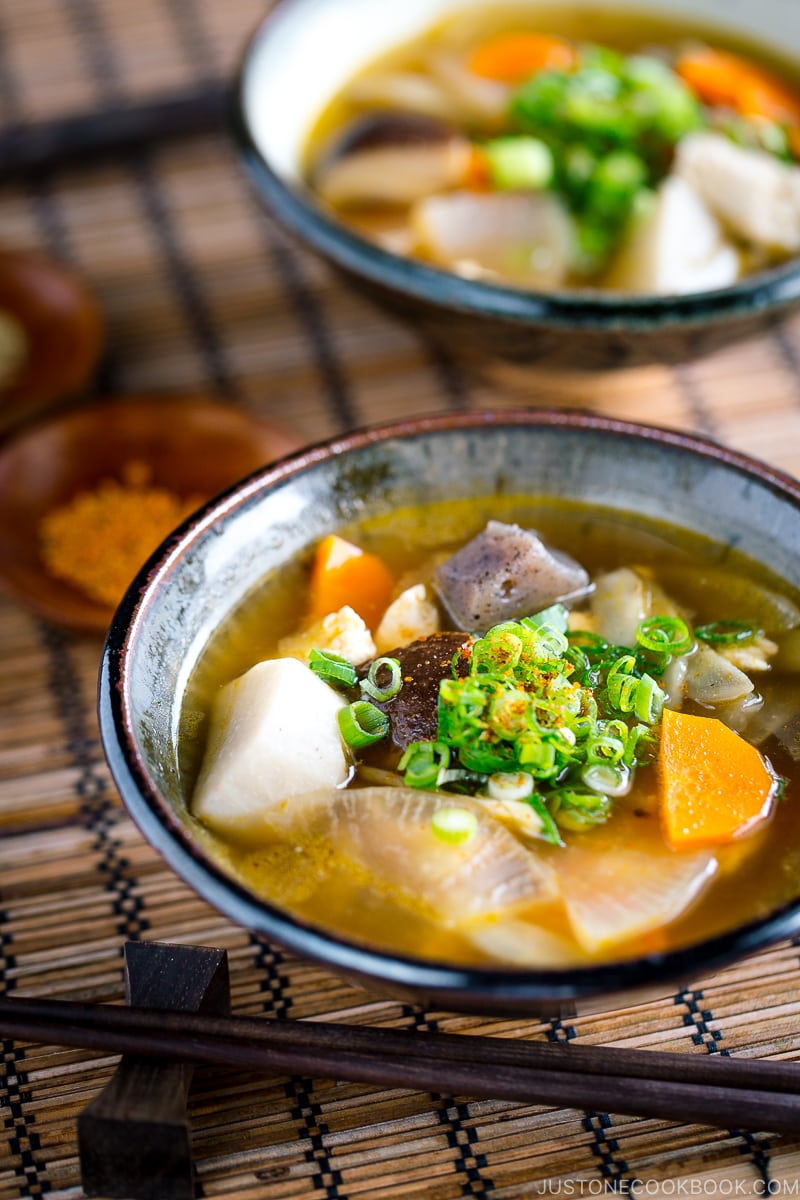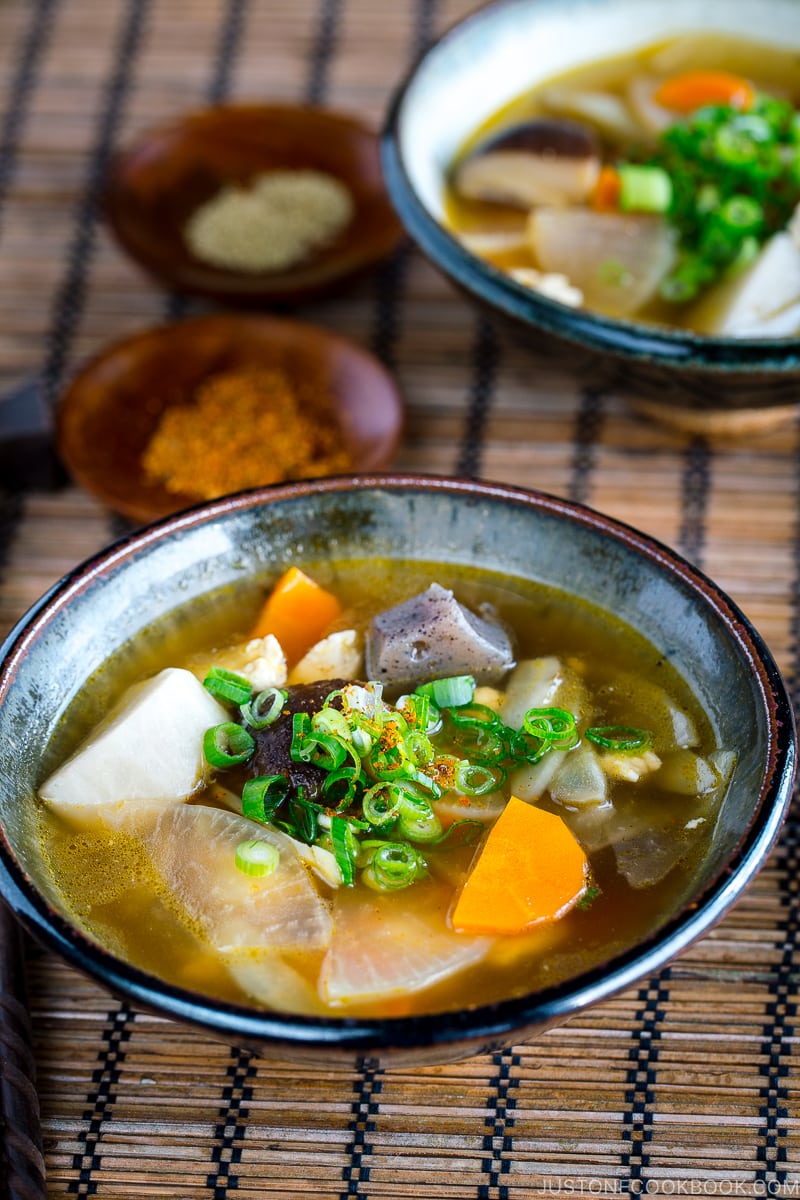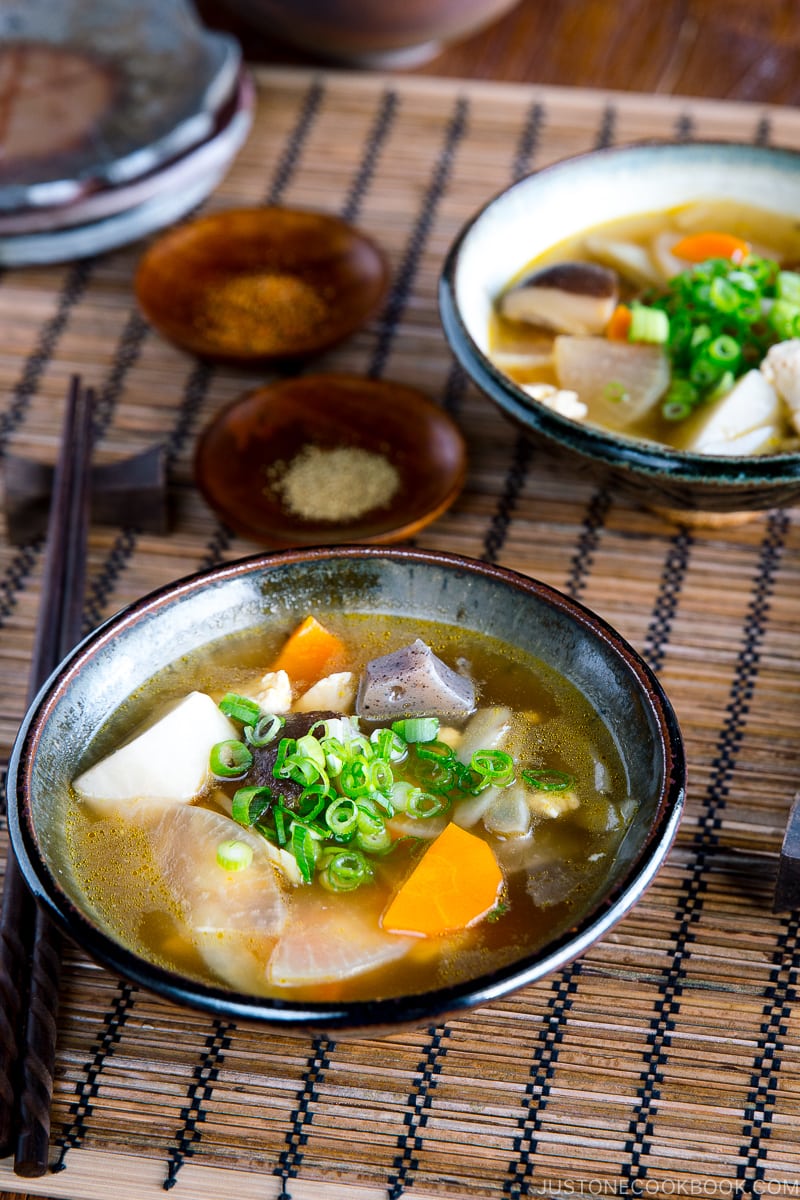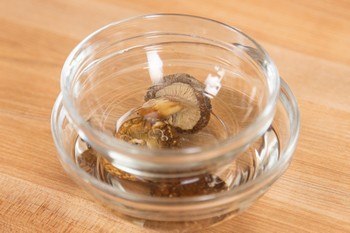Originally created as Buddhist temple cuisine, Kenchinjiru (Japanese Vegetable Soup) is a clear soup cooked with root vegetables, tofu, shiitake, and kombu stock. It’s a well-balanced and flavorful soup for a meatless meal on a cold night. {Vegan}

If you live on the east coast of the US and currently experiencing bone-chilling weather, I thought a nice hot bowl of hearty vegetable soup will warm you up. This soup is called Kenchinjiru (けんちん汁) and it’s a clear soup made with root vegetables and tofu.
What is Kenchinjiru?
Kenjinjiru or sometimes spelled as Kenchin-jiru (“jiru” means soup in Japanese) derived its name “Kenchin” from “Kencho” – the Zen Buddhist temple, Kencho-ji (建長寺) in Kamakura.
The original Kenchinjiru was considered as a shōjin ryōri (精進料理) or traditional Buddhist temple cuisine, which consists of a vegetarian or vegan diet. While most Japanese cooking requires fish-base stock “dashi“, this soup uses kombu and shiitake mushrooms to flavor the soup.

The Key Ingredients in Kenchinjiru
Although you can use any vegetables, the typical ingredients include different kinds of root vegetables. Among them, I feel gobo and daikon are important ingredients to add flavors and textures to the soup. Both ingredients are easily accessible in Asian supermarkets if there aren’t any Japanese grocery stores around you. Both Chinese and Korean cuisines use them, so try those grocery stores as well.
When you watch the video or see my step-by-step pictures, you might wonder why I cut konnyaku with a spoon and tear tofu with my fingers instead of using a knife. I learned these techniques from my mom. When you cut konnyaku with a spoon, it increases the surface area which creates a higher rate of absorption. The same thing goes with tofu. By creating more surface area for the tofu, it absorbs more flavors as well. Using the same logic, I stir-fry the tofu a little bit in sesame oil to get a nice coating on them.

Other Variations of Kenchinjiru
Originally, the soup is a clear soup made with soy sauce; however, you can also make it with miso, especially if you prefer a bolder flavor for your soup.
Of course, you can add chicken or pork as well. Although I love Tonjiru, a miso soup with pork and vegetable and it’s my favorite kind of miso soup, I like my Kenchinjiru to be very simple with just vegetables without meat. Despite being a vegetarian soup, it is full of flavors from all the vegetables and dashi. There are crunchy root vegetables like gobo, daikon, and carrot, and soft and tender satoimo (taro). Lastly, shiitake mushrooms and tofu suck up all the flavors from the soup and you get to enjoy the delicate flavors as you bite into them.
This hearty soup has plenty of flavors going on, just like a stew. I hope you enjoy this soup!
If you are interested in other healthy Japanese recipes, check out 12 Easy & Healthy Japanese Recipes.

Wish to learn more about Japanese cooking? Sign up for our free newsletter to receive cooking tips & recipe updates! And stay in touch with me on Facebook, Pinterest, YouTube, and Instagram.

Kenchinjiru
Video
Ingredients
For the Vegan Dashi
- 1 piece kombu (dried kelp) (4 x 4 inches, 10 x 10 cm per piece)
- 5 cups water (for the kombu)
- 3 dried shiitake mushrooms
- 1 cup water (for the shiitake)
For the Soup
- 7 oz firm tofu (½ 14-oz block)
- ½ package konnyaku (konjac) (4.6 oz, 130 g)
- 7 oz daikon radish (2 inches, 5 cm)
- 3.5 oz carrot (1 medium)
- 3 pieces taro (satoimo)
- 3.5 oz gobo (burdock root) (½ gobo)
For the Seasonings
- 1 Tbsp toasted sesame oil
- 3 Tbsp sake
- ½ tsp Diamond Crystal kosher salt
- 2 Tbsp soy sauce
For the Garnish
- 2 green onions/scallions
- shichimi togarashi (Japanese seven spice) (optional)
- Japanese sansho pepper (optional)
Instructions
- Gather all the ingredients.

To Prepare the Ingredients
- The Previous Night: Gently clean 1 piece kombu (dried kelp) with a damp towel. NEVER wash kombu and do not remove the white powder (that’s where the umami flavor is). These days, kombu is pretty clean. Soak the kombu in 5 cups water overnight. If you don’t have time, skip soaking and go to the next step.

- The Next Day: Slowly bring the kombu and water to a boil. Right before the water boils, remove and discard the kombu. Turn off the heat and set it aside.

- Put 3 dried shiitake mushrooms in a small bowl and cover with 1 cup water. Place a smaller bowl on top to keep the mushrooms submerged.

- Wrap 7 oz firm tofu with a paper towel and place it on a plate. Put another plate on top to press the tofu. Drain for 30 minutes.

- Meanwhile, cut ½ package konnyaku (konjac) into bite-size pieces. You can use a spoon to cut the konnyaku. By giving the konnyaku an uneven texture, the surface will absorb more flavor. Then, boil for 2–3 minutes to get rid of the odor. Drain the water and set it aside.

- Peel 7 oz daikon radish, 3.5 oz carrot, and 3 pieces taro (satoimo). Cut the daikon in quarters lengthwise and the carrot in half lengthwise. Slice them thinly crosswise so they will cook faster. Cut the satoimo into about ¼-inch (6-mm) slices and soak in water to get rid of the slimy texture.

- Scrape the skin off 3.5 oz gobo (burdock root) with the back of a knife under running water. Cut in half lengthwise and thinly slice diagonally. Soak in water for 5 minutes and drain.

- When the shiitake mushrooms are soft and hydrated, squeeze out the liquid and set aside the mushrooms. Strain the soaking liquid through a fine-mesh sieve to get rid of any particles. You now have shiitake dashi. Set it aside.

- Remove and discard the stems of the shiitake mushrooms and cut the caps into quarters.

To Cook the Kenchinjiru
- Heat a large pot and add 1 Tbsp toasted sesame oil. Sauté the daikon, carrot, taro (satoimo), gobo (burdock root), and konnyaku until the oil coats the ingredients.

- Then, add the shiitake mushrooms. Tear the tofu with your fingers and add to the pot. (If you are using silken tofu, use a knife to cut and add it right before serving.) Tofu will absorb more flavor when it is torn by hand. Sauté until all the ingredients are coated with the oil.

- Add the shiitake dashi and kombu dashi. Bring it to a boil.

- Turn down the heat to simmer. Cook for 10 minutes, skimming occasionally. Use a fine-mesh strainer to skim the foam and scum on the surface. Tip: Fill a measuring cup with water and clean the strainer in it. Change the water when it gets dirty.

- After 10 minutes, add 3 Tbsp sake and ½ tsp Diamond Crystal kosher salt and continue to cook until the vegetables are all tender. Finally, add 2 Tbsp soy sauce.

To Serve
- Right before serving, thinly slice 2 green onions/scallions. Serve the soup and garnish with scallion. Sprinkle with optional shichimi togarashi (Japanese seven spice) and Japanese sansho pepper, if you like it spicy.

To Store
- You can keep the leftovers in an airtight container or the pot and store in the refrigerator for 2–3 days.



























[…] Kenchinjiru […]
[…] Kenchinjiru (clear soup with root vegetables and tofu) […]
[…] Kenchinjiru (Vegetable Soup) […]
Did you slice the mushrooms smaller after quartering them? And can you give us an approximate measurement for 1 taro? I can’t find them fresh so I use the frozen boiled taro balls cut up but I don’t know if I added the right amount. Thanks!
Hi Nicole! No slicing, just quarters. 1 Taro is usually about 2 to 2.5 inches. Hope that helps! 🙂
[…] Kenchinjiru (Vegetable Soup – Vegan) […]
is it okay if i not use sake?
Hi Yenni! If you don’t consume alcohol, I guess there is no choice and you’ll have to replace it with water.
If you can drink alcohol, I still recommend to use sake because it has nice umami in sake (from rice). You can sub with dry sherry or Chinese rice wine, if you can’t find sake locally. 🙂
I made this soup tonight, and my husband and I agree that this soup should be in our weekly rotation. Thank you Nami for sharing the recipe.
Hi Gwen! Yay! So happy to hear you two enjoyed this recipe! Thank you for trying it and writing your kind feedback. 🙂 xo
Hi Nami,
Thanks for the recipe, I’m trying the recipe now and it looks delicious. By the way I’m wondering what you will do with the cooked kombu. It seems such a waste to throw it away – do you have any recipes to cook the kombu itself or any suggestions on what to do with it?
Thank you,
Tania
Hi Tania! I use cooked kombu (if I have time) to make furikake:
https://www.justonecookbook.com/how_to/homemade-furikake-rice-seasonings/
Some people simmer in soy sauce and mirin, (sake and sugar) to make kombu really soft and flavorful and eat it with rice. It’s more like to enjoy the texture and flavor. Hope this helps!
This looks so nutritious, and losts of umami. I will try this soon since I’m making Nishime, and lot of the ingredients are used in this recipe also.
Hi Jane! That’s true! Lots of root vegetables. Hope you enjoy this recipe. 🙂
Thank you for the recipe …. I will surely try it …. it looks delicious and healthy
Thank you very much Froilan! Hope you enjoy this recipe! 🙂
hi nami,
can i use doenjang paste as miso subtitution? is it same?. thank you
Hi Riska! Unfortunately, it’s not the same as Japanese miso, but if you like doenjang and love the flavor, maybe you might enjoy it? 🙂
OMG, the camera view and the way you make this soup with the background music makes it feel so warm!!! Such a good job Nami!
Aww thank you so much for your kind compliment! We always find something we need to improve from our videos every time. But I’m glad to hear you enjoy our videos! Thank you!!!
Soup looks amazing! I have been looking for vegan soup recipes, I can’t wait to make it. Thanks & love your blog!
Hi Anne! What a great timing! So glad to hear you like this recipe and I hope you enjoy! Thank you very much for following my blog! 🙂 xo
Oh Nami – this simple clear soup so attracts . . . [smiling] since I have slowly turned Buddhist myself over the last decade, it also seems a most appropriate recipe to add to my folder! But most of all thanks for that fabulous tip about tearing tofu with one’s fingers: eat a lot of the stuff but this is the first I have heard of the practice and it does make sense!!!!
Hi Eha! I’m glad to hear you like this recipe! This will be a fabulous recipe when the weather gets colder (meanwhile enjoy the nice summer weather!). 🙂 We break tofu with hands in some recipes, and we don’t do that all the time (and only works for firm tofu). Hope you give it a try! 🙂
Wow! This looks so wonderful! I have never tried with clear soy based soup! I definitely am going to try this recipe this weekend. As always, love love love your video!
Aiko
Hi Aiko! It’s really good and it is a nice break from regular miso soup. I hope you give it a try! Thanks so much for watching my video! xo